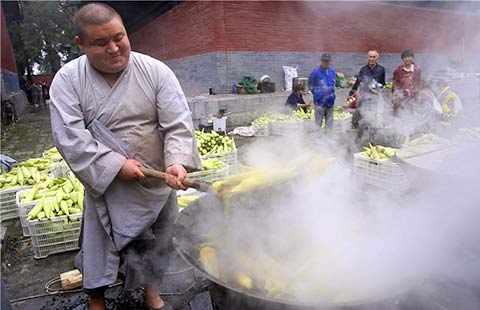
Artemisinin has a history going back to ancient Chinese medicine
What is it?
Artemisinin kills the Plasmodium falciparum parasite that causes malaria. It derives from a plant called sweet wormwood Artemisia annua in Latin, or qinghaosu in Chinese.
It comes to us today from work in the 1970s by Tu Youyou and her team, who spotted references to a fever-easing plant in ancient Chinese medical texts and sought to extract the active ingredient to combat malaria.
Since the 1990s, artemisinin has gradually took on a frontline role, replacing previous generations of medicines that had lost their effectiveness as malaria parasites became resistant.
The drug acts fast initially to attack the parasite and is used in conjunction with longer-lasting medicines to destroy the holdouts, says Teresa Tiffert, a malaria researcher at Cambridge University.
How did it change malaria treatment?
Artemisinin has greatly increased the odds of survival for people hit with the most stubborn strains of the disease.
The chances of dying from malaria have halved from one in five a decade ago to nearly one in 10 today.
While vital, it is but one element in a broader strategy to fight malaria, which includes simple, low-cost measures such as distributing insecticide-treated mosquito netting.
The coordinated effort has driven down deaths by nearly three-fourth over the past decade, says Colin Sutherland, a parasitologist at the London School of Hygiene and Tropical Medicine.
World Health Organization statistics show malaria deaths fell from about 2 million a year in the early 2000s to an estimated 584,000 in 2013.
Health authorities estimate there are nearly 200 million new cases of the disease every year, with about 90 percent of the deaths in Africa.
What is next?
The malaria parasite has a tremendous ability to mutate, causing it to build resistance to treatments when they are prescribed or used incorrectly.
There have been two examples in history of malaria drugs losing their effect, at a cost of millions of lives. From the 1950s to 1970s, chloroquine-resistant parasites spread from Asia to Africa. Chloroquine was then replaced by sulphadoxine-pyrimethamine, which itself lost its parasite-killing powers and was followed by artemisinin.
In February, researchers said they had observed malaria strains showing resistance to artemisinin in Myanmar, raising fears they might spread.
In Africa, where malaria claims most of its victims, some artemisinin-based therapies are also no longer working as well as they used to, doctors say.
At a WHO meeting this year, experts will weigh recommendations to strengthen the combination therapy, perhaps by increasing doses of the drug or the duration of treatment.
"I'm reasonably confident that we can get another five to seven, maybe 10, years' life out of our artemisinin combination approach, by which time we should have a new generation of combination therapies ready to go," Sutherland adds.
(China Daily Africa Weekly 10/09/2015 page7)








